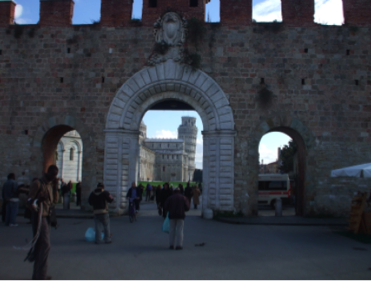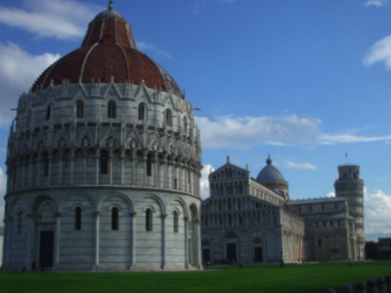Part III. Italy
Chapter 41. Approaching Pisa [January 3, 1348]
Cultural Explanations
 |
Part III. Italy Chapter 41. Approaching Pisa [January 3, 1348] Cultural Explanations |
|
 |
In this chapter Bávlos meets Buonamico Buffalmacco. |
| Nieiddash and Bávlos headed to Pisa |
In this chapter, Bávlos meets the painter Buonamico Buffalmacco. The stories of his boyhood tricks on his master Tafi are drawn from Giorgio Vasari's sixteenth-century Lives of the Painters, in which he recounts these and other tales of Buonamico's apprenticeship and career. Both the story of the trained roaches and of the bishop's monkey come from Vasari. Buonamico also figures in the great Decameron of Boccaccio—more on that in coming chapters!
In this chapter we also see Bávlos beginning work on the new drumhead which accompanies this novel, mixing Christian images with the old figures of his pre-Christian belief system. Such mixing is common on the drums which survive today, many of which date from the seventeenth century, a time in which the old and new religions had merged seamlessly among the Sámi.
Bávlos takes the seagull he sees as a bupmálas (Fulmarus glacialis), a species found on the arctic coast of Scandinavia. Its name in English is the Northern Fulmar, and it is related to the petrel. The gull which Bávlos sees on the road to Pisa is probably not a Northern Fulmar but rather one of the gull species that inhabit the Mediterranean region, such as the species known in Italian as gabbiano reale mediterraneo (Larus michahellis), known in English and the Yellow-legged Gull. The similarity of the Sámi word to Buonamico's surname Buffalmacco is one of the details that convince Bávlos that Buonamico is someone he is meant to meet. The fact that buon amico is Italian for "good friend" further convinces him of the fact.
Pisa was a grand city in the fourteenth century; if you have forgotten details of they, read Chapter 1 again!
 |
 |
| Modern gateway to the Field of Miracles, the site of ancient religious monuments of Pisa | Pisa's baptistery, cathedral, and famous leaning tower. The Camposanto cemetery is to the left of the cathedral. |
 |
| St. Sebastian. North German carving, late 1400s. Skelleteå church, Sweden |
St. Sebastian was a favorite subject in the medieval era and Renaissance. His arrow-riddled body was a powerful image of pain and endurance. St. Sebastian was the patron saint of archers, athletes, and soldiers, but also became a major intercessor for people fearing the Plague. Considering the date and year, Buonamico's painting can be seen as very timely indeed.